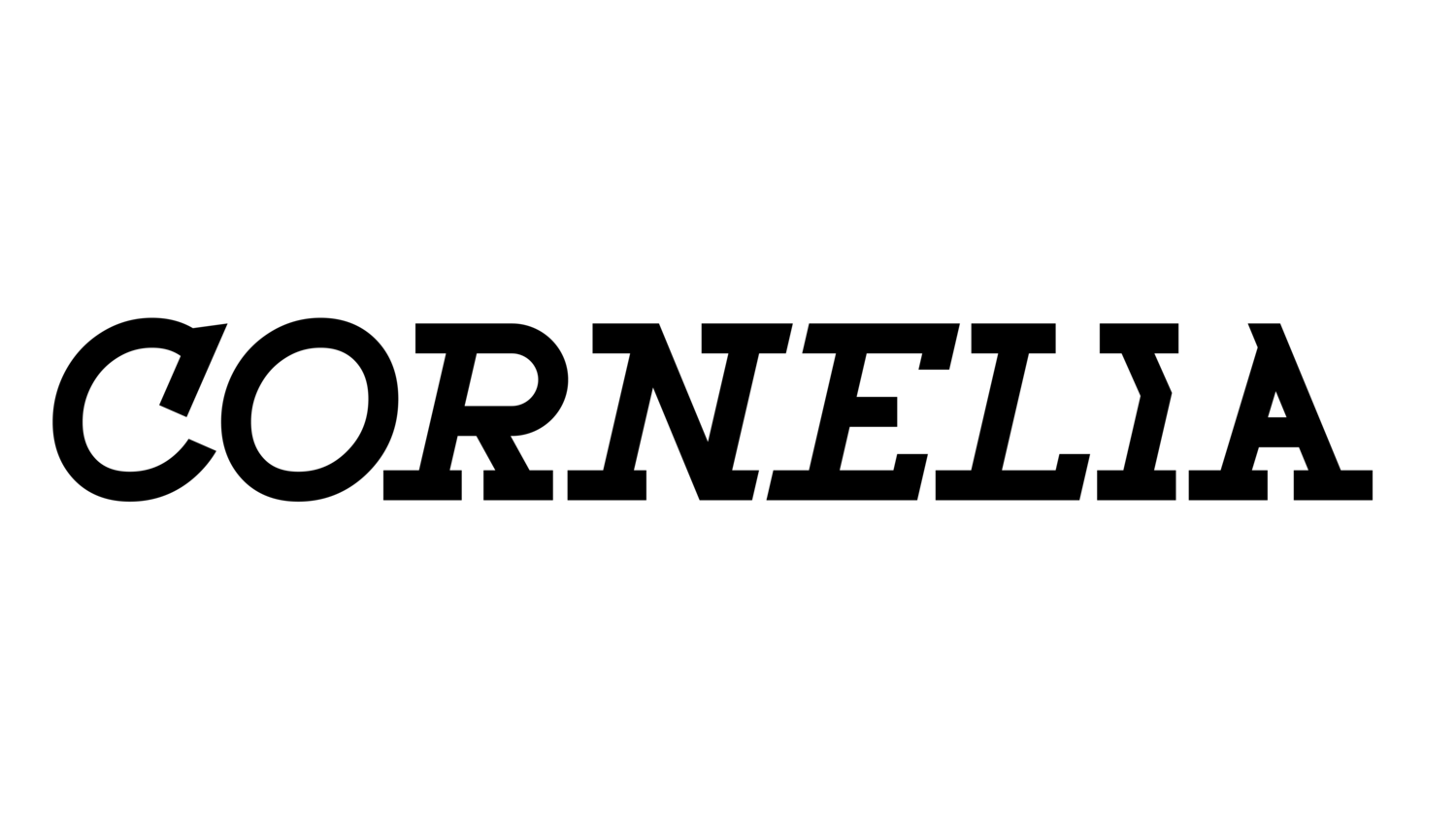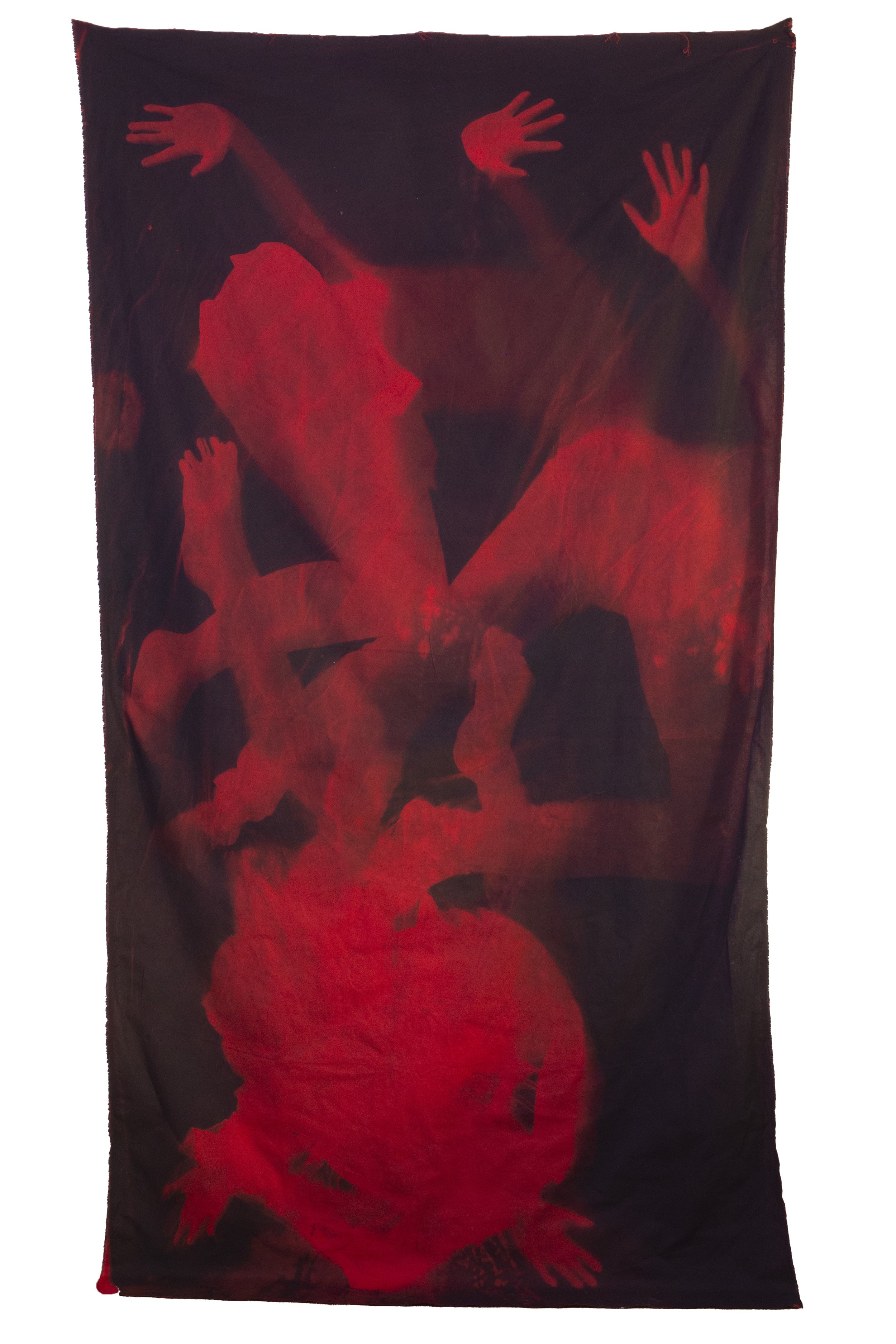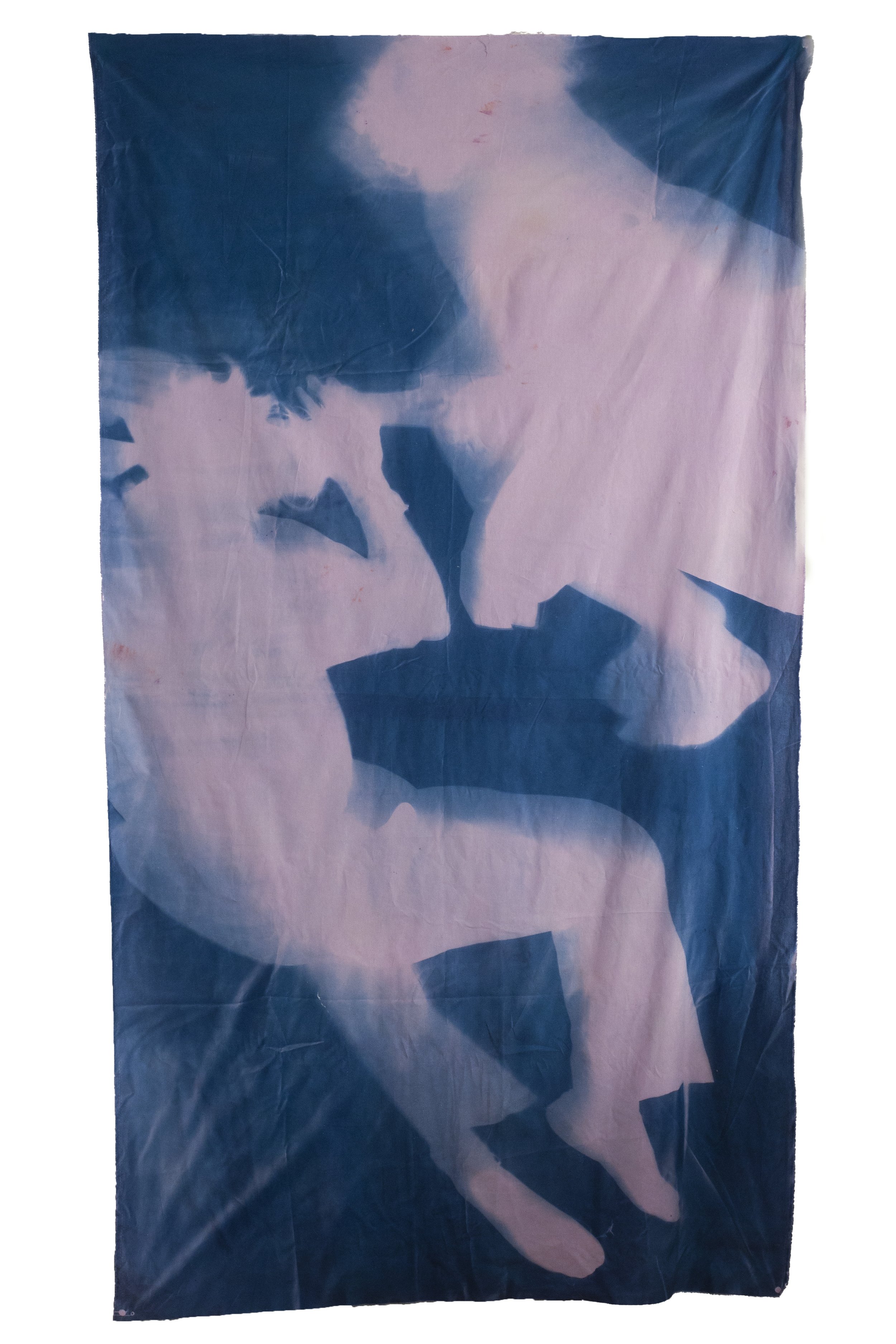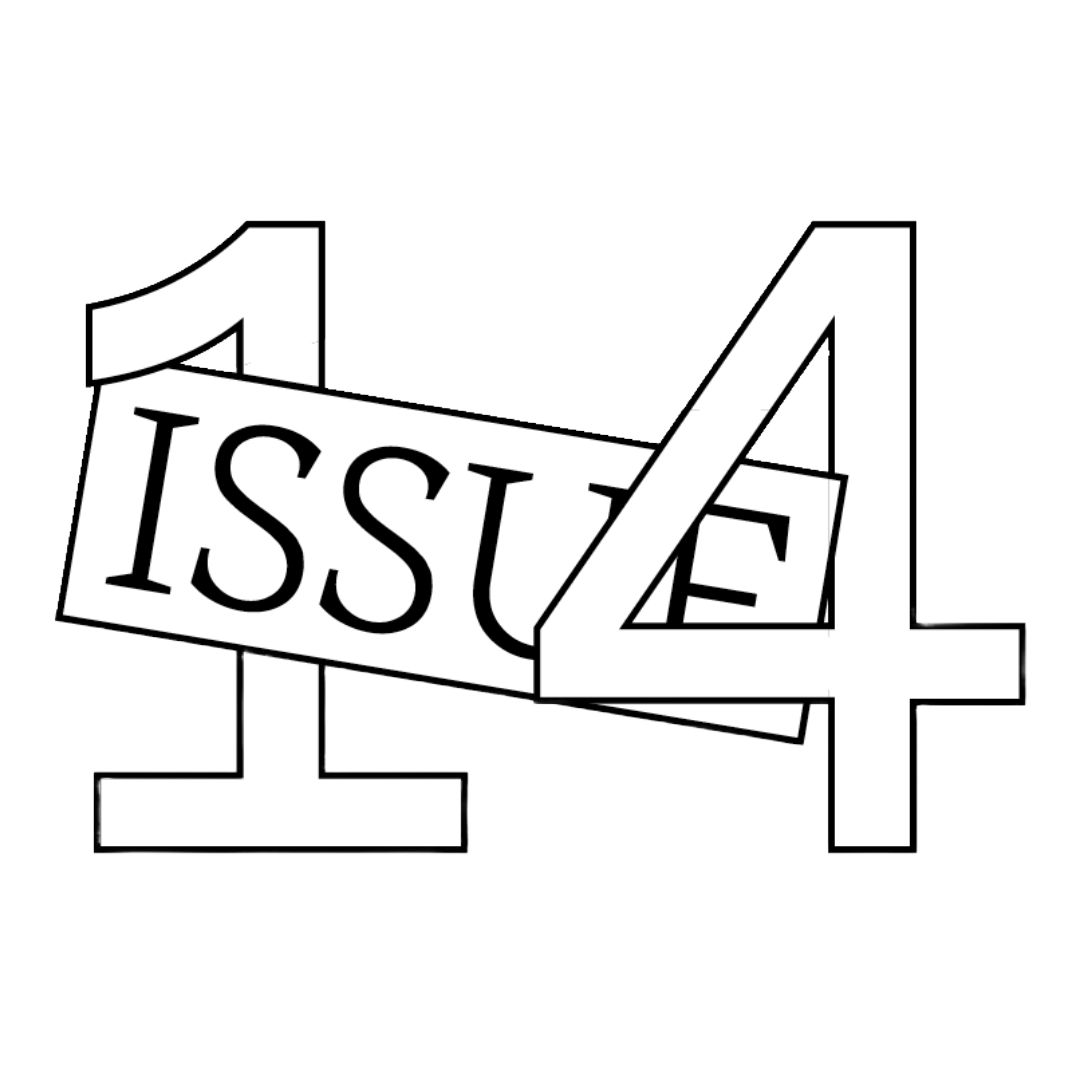The Ineffability of Blue
Leila Fatemi, Untitled, 2022. Screenprint on canvas, cyanotypes on canvas, thread. 21” x 30”
Courtesy of the artist. Photo: Leila Fatemi
** Unfortunately, this image was wrongly credited in print. Our sincerest apologies to the artist, Leila Fatemi. The caption above has been corrected.**In recent years, I have seen a resurgent interest in cyanotype, an historical photographic process that relies on the photosensitive reaction of a simple and safe blend of iron compounds to UV light. It is a practice of image-making in direct conversation with the sun, either in its naturally occurring or synthetic state. Areas of the chemically treated surface exposed to the light turn a distinctively dark blue color, casting into strong relief areas kept covered by, for instance, botanical specimens.
More broadly, sunlight is a source of life responsible for weather, ocean currents, seasons, climate, and photosynthesis. Its presence in art-making alludes to all these things that seem so precious and precarious to witness now, while we, as actors too, confront our own complicities in the climate crisis.
In my immediate community in Toronto, the re-emergence of cyanotype appears to have been, at first, a pragmatic response to lack of darkroom access during the lockdown periods of the pandemic, the increased costs of photographic materials, and the waning vacancy and affordability of studio space. But my various threads of research suggest something more than mere economic practicality. It appears that cyanotype, as an image technology, offers something curious to the cultural consciousness: an exploratory method of building protective worlds within worlds at times of crisis.
Toronto is in the throes of an affordability crisis unlike any in past generations. There is palpable discord between those who view housing as capital and commodity and those who view it as a human right. I recall thinking at the outset of the pandemic that if I could anticipate something on the other side, it would be art, community, and space-making as modes of cultural recovery; I couldn’t envision the soaring food costs and wave of local housing evictions. As someone who came of age in Hamilton in a period of deindustrialization and economic downturn, my mind returned to the collective impetus of my youth, toward altered states of consciousness and togetherness in the face of economic adversity. So it came as no surprise to me that new modes of artist practice have emerged alongside a concurrent resurgence in rave culture, psychedelics, attunement to astronomy, and the sentience of plant life — all counter-cultural activities that seem to be gaining ground in this time of uncertainty.
Against this backdrop, I have been thinking through changes in image-arts practice, particularly a return to analogue processes. I am transfixed by the use of cyanotype as a confluent, hybrid medium and a wave of young artists who are drawn to this 180-year-old photographic method as the basis for hybrid-material explorations in cyano–animation, pattern, and textile — carving out space for numinosity, queerness, tactility, and the body. Following tangential threads of reading and conversation, and piqued interest whenever I spot that distinctive cyan, I ask myself: is this a climate-conscious action? A resistance to the confines of living in late capitalism? A practice akin to sungazing? Why this quest, now, for the ineffability of blue?
Leila Fatemi, An ode to an echo that lingers in my ear, 2021. Cyanotypes on watercolor paper. Various sizes.
Courtesy of the artist. Photo: Toni Hafkenscheid.
In two recent bodies of work, A Vessel to Bend Water (2021) and Tessellations (2023), Leila Fatemi has turned to cyanotype for both its metaphorical and meditative capacities, initially with a critical eye toward the form and later seeking introspection, spirituality, and respite. A Vessel to Bend Water was a longer-term studio and textual investigation that took as its starting point the frequent use of water vessels as props in late nineteenth and early twentieth century postcard and studio portraits of North African women.1 The project unfolds across various media, including textile, ceramic, and photography — here, cyanotype offers a mirror to question the accuracy of how North African women are recorded and Orientalized in the cultural imaginary. In building and mining collections and converting digitized images back to analogue prints, Fatemi cycles through the image making process to sort, select, reproduce, and make material how the colonial gaze is “blueprinted” in Western visual culture. As the original blueprint technology, cyanotype offers a conduit for this metaphor — revealing how constructed images of the East were designed and templated for consumption in the West. Process is integral too. In making cyanotypes, immersion in cold running water washes away unused iron salts and fixes the image. Working directly with water becomes a self-reflection on the visual motif of water vessels as a conceptual and performative element of the work, centralizing Fatemi’s own labor in generative and prismatic ways.
Retreating to the physical and psychic spaces of spirituality often offers grounds for personal healing and greater connectedness. For Fatemi, Tessellations followed a period of intense studio production and provided respite from the critical labor involved in the research and framing of the Vessels project. Tessellations is a series of cyanotype prints and embroidered works on paper that explore the patterns, shapes, and forms of Islamic geometric designs. The iterative pattern work opens Fatemi’s practice to spirituality as a mode of production that evokes a flow state, holds her attention, and connects her to the divine.
The tenets of sacred geometry posit that the mathematical exactitude and structure of specific geometric patterns in nature provide evidence of divine planning and creation. For generations of Islamic creators, geometry is the blueprint of the universe. Esoteric dimensions of spirituality are present in the material world through natural geometries that tessellate and repeat expansively, and architectural ornamentation that aspires to the same. Fatemi created the cyanotypes of Tessellations through a meditative process of hand-cutting patterns that reference such ornamentation and that act as masks during the cyanotype’s exposure to the sun. In their contribution to image-making, these patterns harness and materialize the affective role of sunlight in sacred architectural spaces. The practice of patterning itself ripples outward, ad infinitum, connecting Fatemi to the greater universe.
From left to right: Gabrielle Tyrie, Red, 2023. Cyanotype on cotton. 44 x 78 inches. Courtesy of the artist. Photo: Gabrielle Tyrie. ; Gabrielle Tyrie, Lilac, 2023. Cyanotype on cotton. 44 x 78 inches. Courtesy of the artist. Photo: Gabrielle Tyrie.
Gabrielle Tyrie finds as much meaning in the photosensitive molecules that make up her images as in the images themselves. She produces photo/textile works that entangle cyanotype within liminal spaces of portraiture and performance, including a recent series of sun prints of her body alongside those of friends and loved ones. Process is a form of meditative collaboration for Tyrie, and she cites the chemical reactions of iron and sunlight as actors, too, analyzing the molecular meaning of her material contributors in poetic ways.
Tyrie works through ideas of quantum and queer theories, looking to the physics of particle entanglement as a mirror to queer relationships. Quantum entanglement posits that when two particles are “entangled,” they remain connected even when separated by vast distances. For Tyrie, the metaphorical resonances of quantum entanglement parallel how queerness manifests in many layers and types of relationships, identities, and bonded intimacies, and create imaginative possibilities to materialize as photographic imagery. The imagery results from a correlated system with cyanotype: there is a mutual association between material elements (iron and sunlight) that find each other across vast distances to render intimacy and tenderness in seemingly ineffable ways. This impulse follows the lead of theorists like Karen Barad, who push even further still and see quantum physics as a means of revising the determinate nature of our thinking. In its unknowability, quantum physics resists categorical constructs. It contradicts, at a subatomic level, what we see.2 Perhaps then, through the weird truths of quantum physics, we can understand reality itself as fundamentally queer.
I met Tyrie at Open Studio, an artist-run printmaking center where she worked as an artist-in-residence in 2023. Open Studio is a neighbor to the artist-run photo center Gallery 44, where I work as executive director, and the organizations both serve as common spaces of artistic production, skill and knowledge exchange, critique, and support. Tyrie and I discussed the importance of shared artist workspaces or “third places,”3 as she referred to them: creative centers that provide community outside of work and home. Spaces like Open Studio create opportunities for network-based, intergenerational learning, and preserve and disseminate technical knowledge in informal, inclusive, and affordable environments. They are spaces for the formation of chance bonds as well as intentional, long-lasting friendships. They also provide havens amid Toronto’s general affordability crisis and the specific inaccessibility of art schools.
All these ideas manifested in a real way during my meeting with Tyrie at Open Studio. Also on site that day was Sally Ayre, an artist-member of Gallery 44, where she also teaches cyanotype. I introduced Ayre to Tyrie, and she examined the textile prints laid out for our studio visit. It sparked a story about an experience with Barbara Astman at OCAD University, and a class project that involved making sun prints of one’s body outside in the school’s courtyard. I knew generally about Astman’s work as a photographer but not necessarily about her work in alternative processes. That evening, my research led me to a cyanotype self-portrait from 1975 she posted on Instagram in 2021. Her caption reads, “This is a small self-portrait cyanotype that I made as a sample while teaching at OCA (OCAD U). I remember the house, 9 Lakeshore Drive at the foot of 1st Street. I loved living on the lake. This was taken in the sunroom overlooking Lake Ontario where I took many, many photographs. I have used it as a sample to show my OCAD U students when teaching the historical processes classes. This one escaped the archival banker boxes heading to the AGO and was gifted to my friend.”
Tyrie showed me a series of cyanotype body prints on textiles that she produced at home, in a local park, and on the rooftop of 401 Richmond, the building where both Open Studio and Gallery 44 are long-time tenants. One was a portrait of herself and an artist mentor. She described the intimacy of laying together on the coated cotton ground during the cyanotype’s fifteen-minute exposure and, in her meditative state, imagining the sound of photosensitive iron salts reacting to the sun. As we unfolded stacks of textile, she pointed to places where chance, too, appeared in the images: where a clover blew onto the surface or gradations in color saturation caused by cloud cover.
Ron Siu, The Deceiving Eye (still), 2023. Experimental cyanotype print animation including elements of AI image generation. Courtesy of the artist.
The phenakistoscope — an early animation technology that takes its name from the Greek for imposter — inspired Ron Siu’s non-narrative animation, The Deceiving Eye (2023). Siu’s animation of cyanotype prints in abstract sequences blends and conflates analogue and digital images to reflect the wonder and tension around emergent technology, such as AI, in our contemporary moment. The tricky, analogue layering of digital images may deceive the eye into believing the imagery was drawn through human touch; hence, the title. In this deceit, Siu harnesses new ways of approaching technology that simultaneously embrace anxiety, fantasy, and softness.
The six-minute silent animation integrates AI-generated images with 3D rendered graphics and hand drawings. Siu cites early surrealist animation and 2000s video games as references; he turns to cyanotype for its ability to convert digital images and conceal their origins through analogue touch. Soft imperfections that result from the sequencing and animating of hundreds of cyanotype prints read like the optical textures, grain, or noise of moving picture film. In addition to its affective tactility, cyanotype carries, as he reflects, a specific “photographic signifier.” Just as the emergence of film opened new ways of looking and seeing, and cyanotype transformed the reproducibility of images, today, AI offers a new world and way of thinking and seeing for image-makers that is curious, exciting, and unsettled.
I discussed the strange surreality of AI images with Siu. In The Deceiving Eye, running hares and flying birds whose legs and wings appear, at times, stilted and stalky adorn swirling phenakistoscopes. These are among a few machine-generated images integrated in the work: they began as AI-generated illustrations that Siu reproduced as cyanotype prints, digitized, and then animated. After he identified them to me, the machine-generated elements began to read as bizarre and uncanny, especially when set against the animation’s hand-drawn scenes, like a figure whose back is layered with the moving wings of a butterfly: my impression of the former was peculiar and unsettling and the latter, tender and imaginative. It wasn’t lost on me that Siu made this work one hundred years after Man Ray’s first animation, Return to Reason (Le Retour à la raison) (1923). Man Ray’s experimental short film is a kinetic extension of his photography, including his photograms. Despite following this art historical lineage, Siu’s work resonates with and awakens the present in multifaceted ways — taking on analogue tactility as a queer strategy for image production and referencing forms of appropriative storytelling.
As we shared our anxieties about AI content, especially its threat to creative agency, Siu pointed to recent reportage on writers of fan fiction who discovered their work being scraped, ingested, and imitated by unregulated AI platforms like ChatGPT, which profit from and aid in the AI arms race.4 In creative rebellion, these writers have published irreverent, nonsense-based content, started making their stories private, or entirely removed their work from the web (the genre’s primary mode of community dissemination) to share through other, more protected pathways. Siu noted that The Deceiving Eye reflects on a moment of uncertainty, living in the now with access to new technologies but without a clear picture of the future, amid mass anxiety concerning said technologies, the economy, politics, and the climate. And yet, artists continue to negotiate external and internal pressures to express a clear positionality and to stake a claim despite this rapidly changing: a tall order in the face of a future unknown.
Perhaps there is freedom in the smaller encounters: in micro-networked relationship-building, in conversation, in studio visits, in touch, in inner worlds that detach from the global digital and offer spaces of workshop and community.
Perhaps the materiality of cyanotype, which connects to something elemental and universal, is a pathway to those inner worlds.
Ron Siu, The Deceiving Eye (still), 2023. Experimental cyanotype print animation including found graphics of computer-rendered forms from 90s early 3D video games. Courtesy of the artist.
1 The artist gathered these images from various vintage postcard shows as well photographs made available through the Getty Research Institute, home of the Ken and Jenny Jacobson Orientalist Photography Collection, https://www.getty.edu/research/special_collections/highlights/middle_east/index.html.
2 Karin Sellberg and Peta Hinton, “Introduction: The Possibilities of Feminist Quantum Thinking,” Rhizomes: Cultural Studies in Emerging Knowledge 30 (2016), http://www.rhizomes.net/issue30/intro.html.
3 A term coined by urban sociologist Ray Oldenburg, “third places” refer to social surroundings separate from work and home, where people gather voluntarily and informally. Oldenberg posits that their virtues include encouraging dialogue, grassroots politics, and functioning democracies.
4 Michael Barbaro and Sheera Frenkel, “The Writers Revolt Against A.I. Companies,” July 18, 2023, in The Daily, produced by The New York Times, podcast, https://www.nytimes.com/2023/07/18/podcasts/ the-daily/ai-scraping.html







